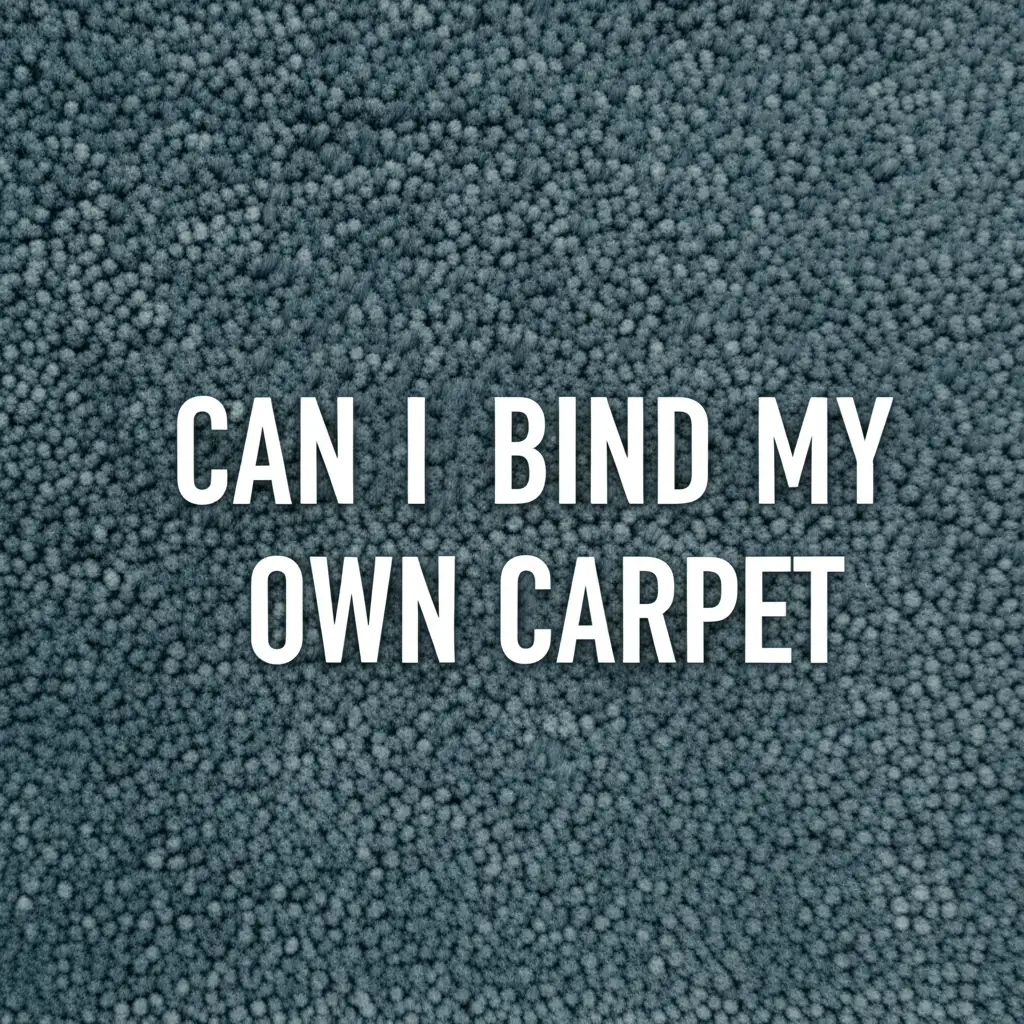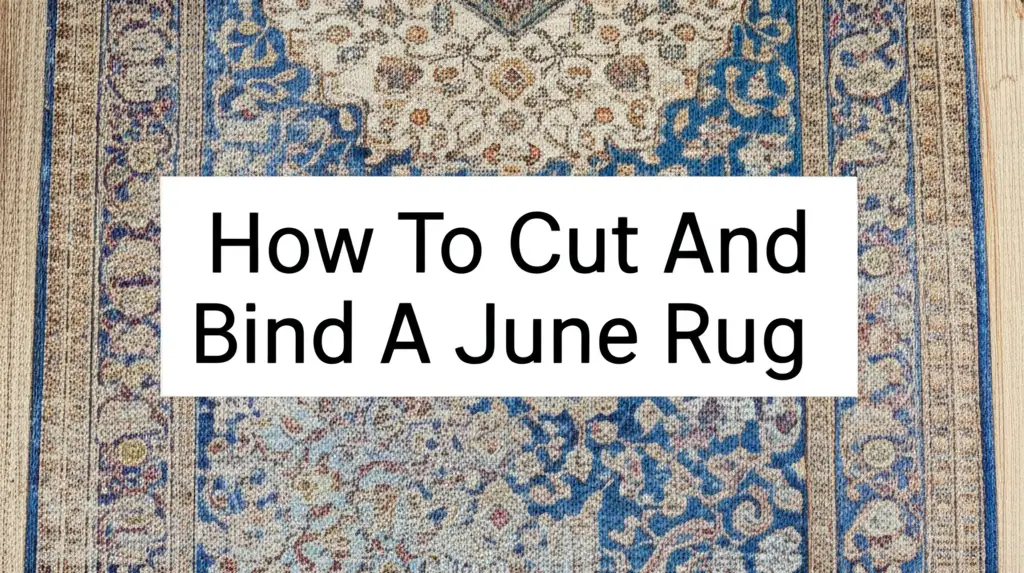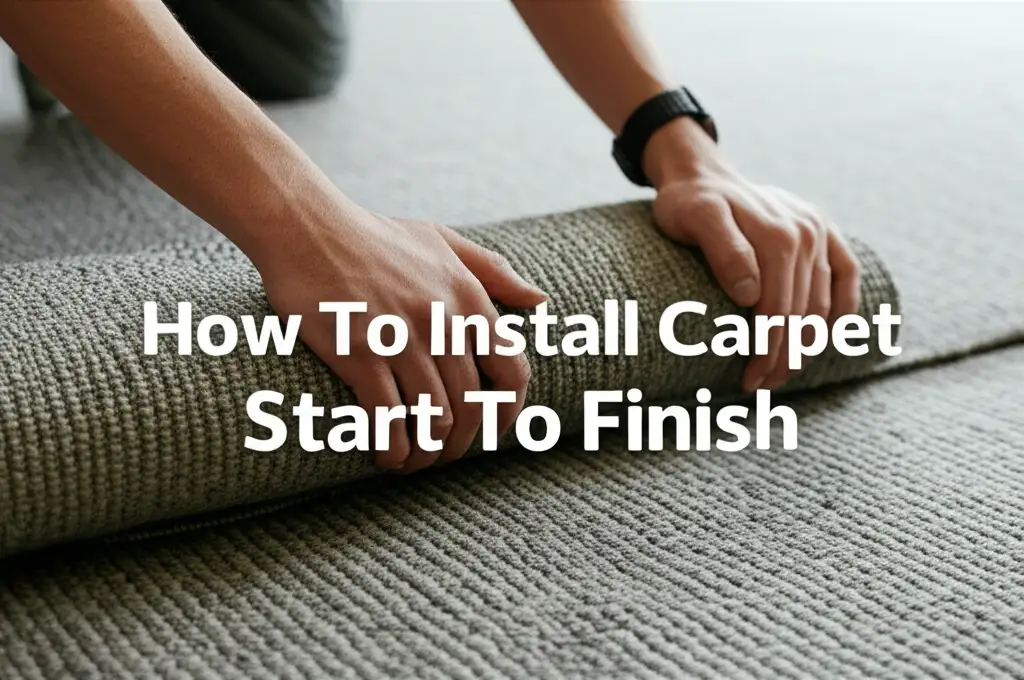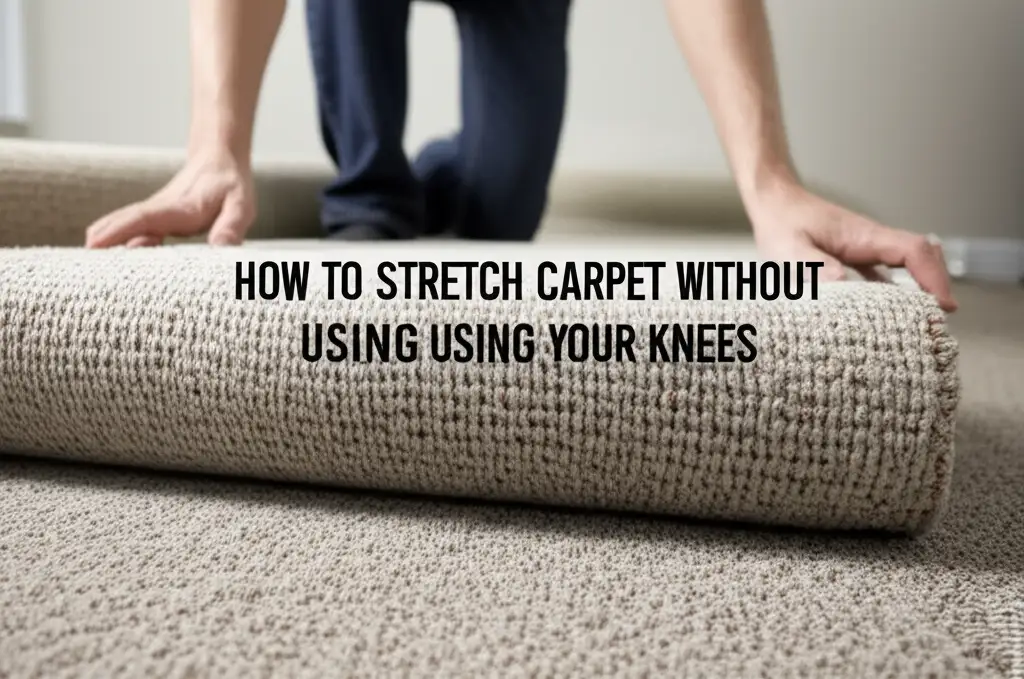· Liora Benning · DIY Home Improvement · 19 min read
Can I Bind My Own Carpet A DIY Guide to Professional Edges

Can I Bind My Own Carpet: A DIY Guide to Professional Edges
Ever looked at a beautiful rug or carpet remnant and wished you could give its edges a professional, finished look? Many people wonder, “Can I bind my own carpet?” I understand this curiosity. Transforming raw carpet edges into neat, durable borders seems like a big task. This article provides a complete guide. We will explore various DIY carpet binding methods. I will show you the tools you need. I will also share tips for achieving a professional finish. Get ready to turn those carpet pieces into custom rugs or runners.
Takeaway: Your DIY Carpet Binding Journey Starts Here
- Yes, you can bind your own carpet. Many DIY methods exist.
- Choose the right method. Options include tape, hot glue, or simple hand-stitching.
- Gather essential tools. You will need sharp scissors, measuring tape, and the chosen binding material.
- Precision is key. Accurate cuts and careful application create the best finish.
- Protect your investment. Binding adds durability and prevents fraying, extending carpet life.
Yes, you can certainly bind your own carpet. DIY carpet binding allows you to create custom rugs or finish off remnants. Different methods exist for different skill levels and desired finishes. With the right tools and a bit of patience, you can achieve a durable and professional-looking edge.
Understanding Carpet Binding: What It Is and Why It Matters
Carpet binding is a process. It involves securing the raw, cut edges of a carpet. This process prevents fraying. It gives the carpet a clean, finished appearance. Think of it as hemming a piece of fabric. A bound edge looks polished. It also protects the carpet fibers.
Many people choose to bind carpet remnants. These pieces often come from larger installations. Instead of discarding them, binding turns them into useful area rugs or runners. This saves money. It also allows for creative use of materials. Properly bound edges make a carpet last longer. They stop edges from unraveling. This keeps the carpet looking new for a longer time.
Binding is more than just aesthetics. It adds structural integrity. The bound edge reinforces the carpet. It makes the carpet more resistant to wear and tear. This is especially true in high-traffic areas. A professional bind gives a factory-made look. It elevates the overall quality of the carpet piece. You can match the binding material to the carpet. You can also choose a contrasting color for a design statement. I find that selecting the right binding material is a key step.
Why Bind Your Own Carpet? Benefits Explored
Binding your own carpet offers several clear advantages. First, it is cost-effective. Professional carpet binding services can be expensive. Doing it yourself saves money. You use materials you already have. You also recycle carpet pieces. This reduces waste.
Second, DIY binding gives you control. You choose the binding material. You pick the color. You decide on the style. This allows for complete customization. You can match existing décor perfectly. You can also create unique accent pieces. I enjoy the freedom this gives for personalizing my home.
Third, it adds durability to the carpet. Unbound carpet edges fray quickly. This makes the carpet look old and worn. Binding protects these edges. It extends the life of your carpet remnants. This means your new custom rug will last many years. It stands up better to foot traffic.
Fourth, you create custom sizes and shapes. Perhaps you need a small mat for a specific spot. Or maybe you want a long runner for a hallway. You cut the carpet to your exact needs. Then you bind the edges. This flexibility is impossible with pre-made rugs. You can transform any carpet piece into a functional item. Binding helps to keep a carpet down by preventing edges from curling up. This keeps the rug flat and safe.
Finally, it is a rewarding DIY project. Learning a new skill feels good. Completing a home improvement project yourself brings satisfaction. You will have a unique item you made. This adds a personal touch to your living space.
Different Methods for DIY Carpet Edging
When you decide to bind your own carpet, you have several methods to consider. Each method has its own level of difficulty and required tools. I will break down the most popular DIY options for you.
- Adhesive Binding Tape: This is perhaps the easiest and most popular DIY method. The tape is usually a strong fabric strip with adhesive on one side. You peel off a backing. Then you press the tape firmly along the carpet edge. Some tapes are heat-activated. You apply heat with an iron to secure them. This method creates a clean, low-profile edge. It requires minimal tools. It is great for beginners.
- Hot Glue Binding: This method uses a strong hot glue gun and glue sticks. You apply a bead of hot glue along the very edge of the carpet. Then you press a fabric binding strip or ribbon onto the glue. This method sets quickly. It can create a very durable bond. However, you must work fast and accurately. Hot glue can be messy if not applied carefully.
- Hand Stitching (Whip Stitch or Blanket Stitch): This method involves sewing a durable thread around the carpet edge. You use a large, strong needle and heavy-duty thread. A whip stitch wraps the thread around the edge. A blanket stitch creates a looped edge. This method offers a handmade, artisanal look. It is more labor-intensive. It requires good hand-eye coordination. This method works well for smaller pieces.
- Machine Stitching (Serging or Binding Machine): This method is less of a “DIY-at-home” option for most people. Serging machines professionally finish edges with a continuous thread stitch. Binding machines sew a fabric tape onto the edge. These machines are specialized and expensive. They are typically used by professionals. However, some very advanced DIYers might consider renting one or using a heavy-duty sewing machine if they have the right attachments. I focus on methods more accessible to the average home DIYer.
Each method gives a different look and level of durability. I recommend starting with adhesive tape for your first project. It offers a forgiving learning curve.
Essential Tools and Materials for Carpet Binding
Before you begin to bind your own carpet, gathering the right tools and materials is crucial. Having everything ready makes the process smooth and efficient. I always advise a thorough preparation.
Here’s a list of what you will likely need:
- Carpet or Rug Remnant: This is your base material. Make sure it is clean and dry. Cut it to the desired size and shape. Use a straight edge and a sharp utility knife for precise cuts.
- Measuring Tape: Accurate measurements are vital. You need to measure the perimeter of your carpet piece. This tells you how much binding material to buy.
- Sharp Scissors or Utility Knife: A good, sharp cutting tool is non-negotiable. Dull blades can fray the carpet. They make cuts uneven. For carpet, a heavy-duty utility knife with new blades works best. Always use a straight edge for cutting.
- Straight Edge or Ruler: A long, sturdy ruler or a carpenter’s square helps you make perfectly straight cuts. This is important for a professional-looking edge.
- Binding Material:
- Adhesive Binding Tape: This is usually a fabric strip with a self-adhesive backing. It comes in various widths and colors. Ensure you buy enough length for all edges.
- Fabric Binding Strip/Ribbon: If using hot glue or stitching, you will need a durable fabric strip. Canvas, twill tape, or strong grosgrain ribbon work well. Choose a width that suits your carpet thickness.
- Heavy-Duty Thread: For hand-stitching, use upholstery thread or a strong nylon thread. It must withstand wear.
- Hot Glue Gun and Glue Sticks: If choosing the hot glue method, a reliable hot glue gun is essential. Make sure you have plenty of all-purpose glue sticks.
- Fabric Clips or Clamps: These hold the binding material in place as you work. They are very helpful, especially on longer edges.
- Weight or Books: These can help hold the carpet flat during binding.
- Iron (for heat-activated tape): If your chosen binding tape requires heat, a standard household iron will be needed.
- Work Surface: A large, flat, clean surface is ideal. It allows you to spread out the carpet without creasing.
Having these items on hand prevents interruptions. It helps you achieve a neat, durable finish. I always double-check my supplies before starting any project.
Step-by-Step Guide: Applying Adhesive Binding Tape
Adhesive binding tape is my recommended starting point for DIY carpet binding. It is straightforward and yields good results. Follow these steps to bind your own carpet using this method.
- Prepare Your Carpet: Lay your carpet remnant flat on a clean, hard surface. Ensure all edges are cut straight and clean. Any loose fibers should be trimmed. This provides a neat foundation for the tape. Use a utility knife and a long straight edge for precision.
- Measure and Cut Tape: Measure the perimeter of your carpet. Add a few extra inches to each length for overlap. Cut your binding tape pieces to these measured lengths. Remember to cut four separate pieces for a rectangular rug.
- Clean the Edge: Wipe down the carpet edge where the tape will adhere. This removes any dust or debris. A clean surface ensures a strong bond.
- Start Applying Tape: Begin on one of the longer sides if possible. Peel back a few inches of the adhesive backing from the tape. Align the tape perfectly with the edge of the carpet. Ensure half of the tape width is on top of the carpet, and half extends over the edge. This provides good coverage when folded.
- Press Firmly: Press the tape down firmly as you slowly peel off more backing. Work in sections. Apply constant, even pressure. Smooth out any bubbles or wrinkles as you go. Use a roller or a flat object to enhance adhesion.
- Handle Corners: When you reach a corner, there are a couple of ways to handle it:
- Mitered Corner: For a very clean look, cut the tape at a 45-degree angle at the corner. This allows two tape strips to meet perfectly.
- Overlap Corner: A simpler method is to run the tape along one side, then overlap it with the tape from the next side. Trim excess neatly.
- Fold and Secure: Once the tape is fully applied to the top surface, carefully fold the overhanging half of the tape underneath the carpet. Press it firmly against the carpet’s backing. Some tapes are self-adhesive on both sides for this fold. For how to use carpet tape to bind other materials, the principle remains similar.
- Heat Activation (If Needed): If your tape is heat-activated, follow the manufacturer’s instructions. Usually, this involves running a hot iron over the taped edges. The heat melts the adhesive, creating a stronger, more permanent bond. Place a thin cloth between the iron and the tape to prevent scorching.
- Allow to Cure: Let the adhesive fully cure. This can take several hours, or even a day. Avoid moving the carpet during this time. This ensures maximum bond strength.
By following these steps, you can bind your own carpet edges with professional-looking results. Patience and precision are your best friends in this process.
Advanced DIY Techniques: Stitching and Serging Alternatives
While adhesive tape is great, some people prefer or need other methods to bind their own carpet. Hand-stitching and even basic machine techniques offer different aesthetics and levels of durability. I find these methods add a more custom feel.
Hand Stitching for a Classic Finish
Hand-stitching offers a robust and traditional way to finish carpet edges. This method is slower but allows for meticulous detail.
- Prepare the Edge: Ensure your carpet edge is clean and straight. You might want to apply a thin layer of fabric glue (like fray check) to the very edge first. This prevents immediate fraying during the stitching process.
- Choose Your Thread and Needle: Select a strong, heavy-duty thread. Upholstery thread or waxed nylon thread works well. Use a large, curved upholstery needle for easier piercing through the carpet backing.
- Apply Binding Material: You can use a separate fabric strip for a more finished look. This strip should be about 1-2 inches wide. Fold it over the carpet edge. Secure it temporarily with fabric clips. Alternatively, you can just stitch the raw carpet edge directly.
- The Whip Stitch: Begin by bringing the needle up from the back of the carpet, close to the edge. Loop the thread over the edge of the carpet and bring the needle down through the carpet again, about 1/4 to 1/2 inch from your starting point. Pull the thread tight. Continue this motion, creating diagonal stitches that wrap around the carpet edge. Keep your stitches evenly spaced.
- The Blanket Stitch: This stitch creates a neat, decorative edge. Bring the needle up from the back of the carpet. Loop the thread around the edge. Before pulling tight, pass the needle through the loop formed by the thread at the edge. Pull the thread to create a small, neat knot at the edge. Repeat, keeping stitches even.
Hand-stitching gives a very personalized touch. It is perfect for small rugs or decorative pieces.
Exploring Machine Stitching (with caveats)
Using a sewing machine to bind carpet is often done professionally. However, if you own a heavy-duty industrial sewing machine or a specialized carpet binding machine, it is possible. Standard home sewing machines usually lack the power and needle strength for carpet.
- Heavy-Duty Machine: You need a machine capable of handling thick materials. It should have a walking foot attachment. This helps feed thick fabric evenly.
- Strong Needles and Thread: Use denim or leather needles. Choose thick polyester or nylon thread.
- Binding Attachment: Professional carpet binding machines have specialized attachments. These feed and fold the binding tape automatically. Without such an attachment, it is very challenging to get a neat, consistent result.
- Practice First: If attempting machine binding, practice on scrap pieces. Get a feel for the machine’s tension and speed with carpet material.
Machine stitching offers speed and consistency. For most DIYers, hand-stitching or adhesive tape are more practical choices. I believe starting simple is always a good idea.
Tips for a Flawless Finish and Durability
Achieving a professional-looking finish when you bind your own carpet requires attention to detail. These tips will help ensure your custom rugs are both beautiful and long-lasting.
- Precise Cuts are Paramount: A clean, straight initial cut makes all the difference. Use a new, sharp utility knife and a long metal straight edge. Make multiple shallow passes rather than one deep cut. This prevents slipping and uneven edges. Uneven edges make binding difficult and look messy.
- Clean the Edges Thoroughly: Before applying any binding material, ensure the carpet edges are free of dust, loose fibers, and debris. A clean surface allows for optimal adhesion. You can use a vacuum or a damp cloth.
- Measure Twice, Cut Once: This old adage holds true for carpet binding. Calculate the exact length of binding material needed for each side. Add a small allowance for overlap or corners. This prevents running short. It also minimizes waste.
- Work in Sections: Do not try to apply the entire length of binding tape or stitch the whole side at once. Work in manageable sections. This allows for better control. It helps prevent misalignment and bubbles.
- Apply Even Pressure: When using adhesive tape, consistent, firm pressure is key. Use a roller or a smooth, hard object to press down the tape. This ensures the adhesive bonds completely to the carpet fibers. For heat-activated tapes, consistent heat application is also important.
- Proper Corner Treatment: Corners are often the trickiest part. For adhesive tape, a mitered corner (cutting the tape at a 45-degree angle) gives the cleanest look. For stitching, ensure your stitches are neat and tight around the curve. Proper corners prevent fraying.
- Allow Adequate Curing Time: If using adhesive or hot glue, respect the curing time. Do not move or stress the newly bound carpet immediately. This allows the adhesive to reach its maximum strength. Rushing this step can lead to premature failure of the binding.
- Edge Protection: Consider applying a fabric sealant or fray-check product to the very raw edge of the carpet before binding. This is especially useful for hand-stitching or if you fear the carpet will shed. While not always necessary, it offers an extra layer of protection. Binding itself helps protect the carpet. You can also put something over carpet to protect it from heavy wear.
- Choose the Right Binding Material: Match the binding material to the carpet’s thickness and intended use. Thin, decorative ribbon might work for a small, light mat. Heavy-duty twill tape or commercial-grade binding is better for high-traffic area rugs. The right material ensures durability.
By following these tips, you can bind your own carpet effectively. Your finished pieces will look professional. They will also last a long time.
Care and Maintenance of Bound Carpets
You put effort into binding your own carpet. Now, protecting that work is important. Proper care and maintenance will ensure your newly bound rugs stay beautiful and functional for many years. I believe good habits extend the life of any home item.
- Regular Vacuuming: Vacuum your bound carpet regularly. This removes dirt and grit. Dirt can act like sandpaper on carpet fibers. Pay special attention to the bound edges. Loose debris can get trapped there. Use the appropriate vacuum setting for your carpet pile. What is low carpet and high carpet setting on vacuum explains these settings.
- Spot Cleaning Promptly: Accidents happen. If spills occur, clean them immediately. Blot spills with a clean cloth. Do not rub. Rubbing can spread the stain. It can also damage the carpet fibers and the binding. Use a mild carpet cleaner suitable for your carpet type. Always test cleaners in an inconspicuous area first.
- Avoid Harsh Chemicals: Strong cleaning agents can damage both the carpet and the binding adhesive or stitching. Stick to mild, pH-neutral cleaners. If you are not sure, plain water and a clean cloth are often the safest bet for fresh spills.
- Inspect Edges Periodically: Routinely check the bound edges for any signs of wear. Look for fraying, loose threads, or tape lifting. Early detection allows for quick repairs. A small repair now can prevent bigger damage later.
- Rotate Rugs: If your bound rug is in a high-traffic area, rotate it periodically. This ensures even wear across the carpet surface. It prevents one area from wearing out faster than others. This helps maintain the overall look and integrity of the rug.
- Address Loose Threads: If you spot a loose thread on a stitched edge, do not pull it. Use sharp scissors to carefully trim it flush with the binding. Pulling can unravel more of the stitching.
- Re-apply Adhesive (if needed): For adhesive-bound carpets, if a section of tape starts to lift, you can often re-apply it. Clean the area. Apply a small amount of strong fabric adhesive underneath the tape. Press firmly. Use weights while it cures.
- Professional Cleaning (if necessary): For deep cleaning, consider professional carpet cleaning services. They have specialized equipment and knowledge. Inform them about your DIY bound edges. This helps them use appropriate methods. For many smaller rugs, simple cleaning methods work fine. You can generally dry clean a carpet if the material allows it.
Caring for your bound carpets is simple. Consistent small efforts keep them looking new and lasting long. I find that regular attention saves me time and money in the long run.
FAQ Section: Common Questions About DIY Carpet Binding
Q1: How long does DIY carpet binding last? A1: The durability of DIY carpet binding depends on the method used. Adhesive tape can last several years with proper application and care. Hand-stitching with strong thread can be very durable, lasting many years. High-traffic areas may show wear sooner. Regular maintenance helps extend the life of the bound edges.
Q2: Can I bind any type of carpet? A2: Most carpets can be bound. However, very thick carpets or those with very loose weaves can be more challenging. Low-pile carpets and standard cut-pile or loop-pile carpets are easiest to bind. Some very shaggy or frieze carpets may require professional serging for the best look.
Q3: What kind of adhesive tape should I use for binding? A3: Look for specialized carpet binding tape. This tape is usually a durable fabric strip with a strong, permanent adhesive. Some versions are heat-activated for extra strength. Avoid generic double-sided tape or duct tape. They often lack the durability and adhesive power needed for carpet.
Q4: Is professional carpet binding better than DIY? A4: Professional carpet binding machines create an extremely durable, factory-perfect finish. For very large rugs or for carpets that will experience heavy commercial use, professional binding is often superior. DIY binding is excellent for cost savings, custom sizes, and personal satisfaction on smaller projects or residential use.
Q5: Can I bind an irregularly shaped carpet? A5: Yes, you can bind irregularly shaped carpet pieces. Hand-stitching offers the most flexibility for curves and unique angles. Adhesive tape can also work, but you need to make careful cuts and snips in the tape to accommodate tight curves. Precision is even more important for non-rectangular shapes.
Q6: What if my carpet frays during the cutting process? A6: Some carpets naturally fray more than others. Use a very sharp utility knife and a straight edge. Make several light passes instead of one deep cut. If fraying is still an issue, apply a fabric fray-check liquid to the raw edge immediately after cutting, before applying the binding material. Let it dry completely.
Conclusion: Your Journey to Bound Carpet Perfection
I hope this guide has answered your question, “Can I bind my own carpet?” The answer is a resounding yes! Binding your own carpet is a rewarding DIY project. It transforms unused remnants into functional, attractive rugs. You save money. You also get complete control over the design.
We explored various methods. Adhesive binding tape offers ease for beginners. Hand-stitching provides a classic, durable finish. I covered the essential tools you need. I also provided a step-by-step guide for tape application. Remember to prioritize precise cuts. Always apply firm pressure. Pay attention to corner details. Finally, proper care will keep your bound carpets looking great for years. Embrace the creativity that DIY carpet binding offers. You can turn any space into a truly custom home. Start your binding project today!





